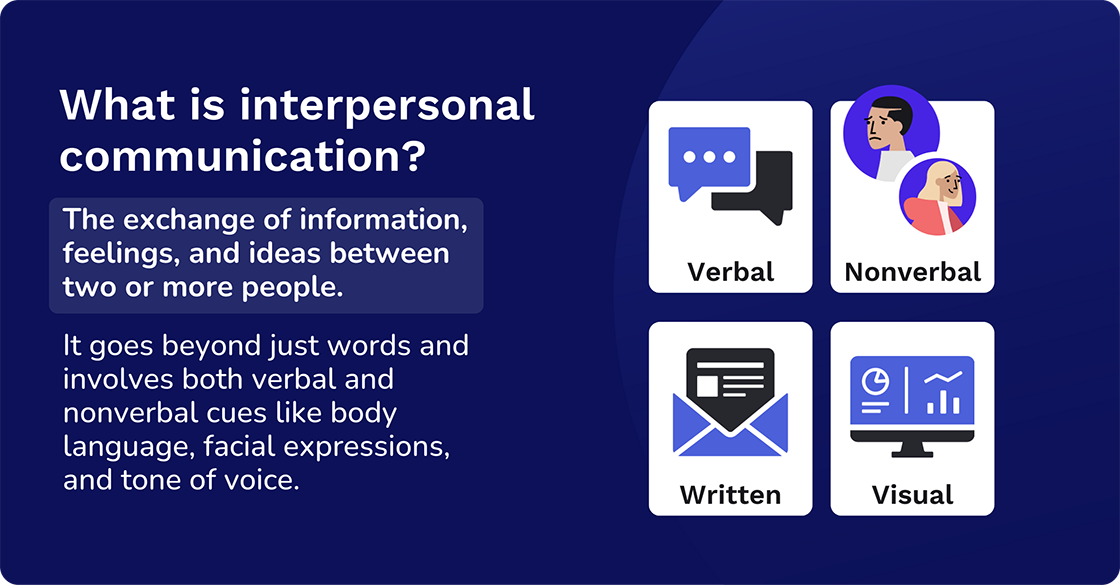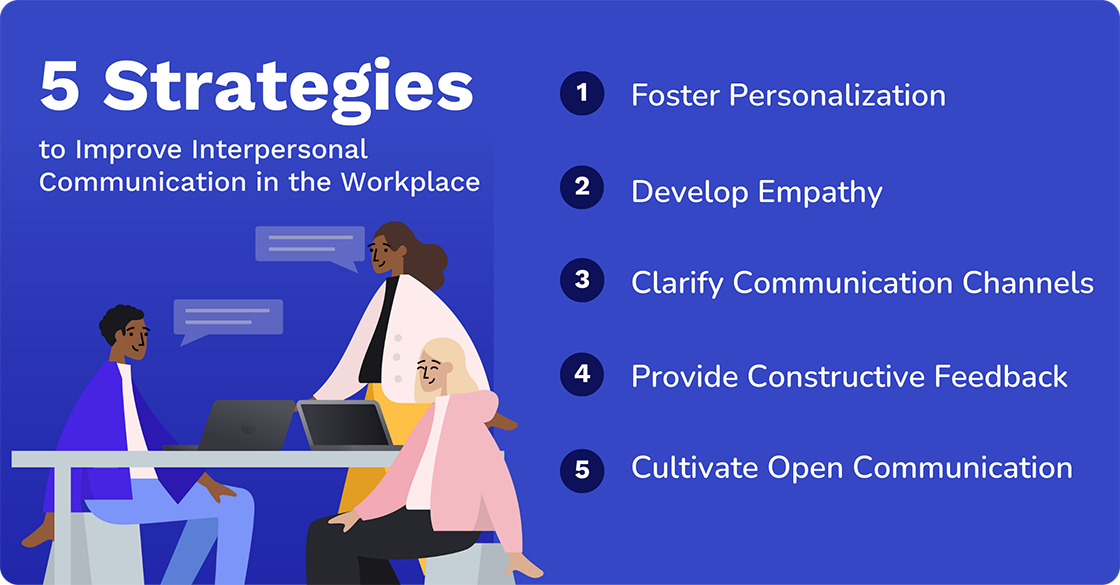Effective interpersonal communication in the workplace can have an incredibly powerful impact on productivity. Want to know more? Don’t miss this post.

.webp)
Effective internal communication is the backbone of every successful organization. Learn the ins and outs of internal communications with our research-backed white paper.
Access NowInterpersonal communication is the exchange of information, feelings, and ideas between two or more people. It goes beyond just words and involves both verbal and nonverbal cues like body language, facial expressions, and tone of voice. It's all about creating and sharing meaning with others.
Communication between people is a fundamental part of human interaction and it is central to any successful relationships, whether professional or personal. So, it stands to reason that both personal and professional communication are constant factors in any workplace environment.
Research reveals that every facet of communication is on the rise. But there is also strong evidence that despite this, rapidly increasing communication in the workplace is increasing overall workloads. This is why it is so important for organizations to work on improving effective communication and eradicating miscommunication.
According to Grammarly’s latest report, developed in partnership with The Harris Poll, “every business is at a tipping point in its relationship with communication.”
The 2024 State of Business Communication report states that knowledge workers spend 88% of their time during the week communicating across multiple channels. In the 12 months from October 2022 to 2023, the frequency of communication in the workplace increased by 78% and the variety of communication channels used by 73%.
“Business performance remains intricately linked to communication. Effective communication yields positive business outcomes, while miscommunication hinders productivity, brings down morale, and negatively impacts the bottom line. Today, effective communication faces challenges due to the sheer amount and variety of messages people receive.”
Grammarly
In this article, we’re going to explore the importance of interpersonal communication in the workplace. We will discuss the different types of interpersonal communication, and suggest how organizations can improve these skills for a more effective and cohesive work environment.
Communication between people in a workplace environment is simply the process of communication as described above, but specifically in a work environment.

Effective interpersonal communication skills are pivotal in fostering a productive workplace experience, enhancing teamwork, and contributing to company culture. Effective communication includes but is not limited to conversations between coworkers, team meetings, and even informal water cooler chats.
The 2024 Grammarly report, developed in partnership with The Harris Poll, states their study found effective communication in the workplace results in:
Poor communication, on the other hand, leads to:
According to Kincentric’s Global Employee Experience Trends 2023, thriving companies achieve a perfect blend of structure and flexibility. They design employee experiences that consistently align with business goals. They also personalize work for different teams and individuals. This creates a unified yet distinctive experience for everyone.
More specifically, they talk about high-performing organizations adding “sand and water” when they look for ways to ensure a good, consistent employee experience (EX). This idea is based on a parable about rocks, pebbles, sand and water filling a glass jar. Rocks can fill a jar, but adding pebbles, and sand show it wasn’t full. The jar isn’t full until water is added to seep into the spaces between the sand.
“The rocks and pebbles represent the foundational elements of an engaging experience — those basic processes and behaviors that are critical in order to develop engagement, such as training to do one’s job, role clarity and trustworthy leadership. The sand and the water represent the more mature and unique elements that have evolved beyond the foundational elements to further enhance the work experience.”
Kincentric
In today's fast-paced business environment, good interpersonal communication skills ensure that team members are on the same page. It also helps in solving problems efficiently and contributes significantly to internal communication. With the introduction of new digital technologies such as artificial intelligence (AI) and virtual reality (VR), communicators will need to find a way to deliver personalized messages to their employees.
Socializing in the Metaverse: The Innovation and Challenge of Interpersonal Communication states that social interaction is entering the fourth era — metaverse social interaction. Although it is “a new hot concept,” they say it's really an upgrade of augmented reality (AR) and VR. At the same time, the higher stage of “virtual” includes human interaction. “This kind of interpersonal communication will be a new deep immersive virtual communication space, making virtual communication an important form and content of human communication.”
While the 2024 Grammarly report doesn’t talk about VR, it focuses heavily on the power of AI. With miscommunication costing U.S. businesses an estimated $1.2 trillion every year (2022 report), and communication being on the rise but less effective (2023), 2024 promises new solutions and challenges through AI.
“Which way each business tips will depend on how well it scales effective communication across the employee base and how effectively it moves from an experimental posture with AI to one of standardization.”
Grammarly
The report goes further, claiming that using generative (gen) AI for communication could save the U.S. as much as $1.6 trillion in productivity. But its potential is largely untapped at this point in time.
There are also glaring gaps between what leaders and “workers” do with AI. While 89% of business leaders actively use gen AI for “professional purposes,” only 53% of knowledge workers use it.
Turn your internal communications strategy around today

Interpersonal communication in the workplace manifests in various forms. Recognizing the various types helps in understanding how best to communicate with colleagues and foster a positive work environment.
The main types include:
Developing proficiency in these types of communication can lead to stronger interpersonal relationships, better conflict management, and more effective teamwork.
Knowing when and how to use each type of communication is a key interpersonal skill. For instance, complex ideas may be better presented visually or in written form to ensure details are not missed. More sensitive issues, on the other hand, may be best addressed through direct verbal communication, utilizing nonverbal cues to gauge and respond to reactions.
While interpersonal communication focuses on exchanges between two or more people, intrapersonal communication relates to internal dialogue within an individual person. This includes self-talk, personal reflections, decision-making processes, and internal reactions to external situations.
Intrapersonal communication is the foundation upon which interpersonal communication skills are built. This is because it relies on understanding oneself, leading to better understanding of others. All-in-all, it improves one’s ability to communicate effectively.
Mass personal communication is a relatively new concept brought about by the advent of digital technology and social media. It blends elements of mass communication — the delivery of information to a large audience through mediums like television and newspapers — with personal communication. The latter, of course, includes direct, two-way exchanges between individuals. Mass personal communication allows personalized messages to be shared with a broad audience or group, often leading to public and personal interactions.
Interpersonal communication, on the other hand, traditionally occurs in smaller, more personal settings. It involves direct exchanges between individuals or small groups and is characterized by immediate feedback. With the rise of digital technology, however, the lines between interpersonal and mass personal communication have blurred. Platforms overview tools like social media that enable users to engage in what feels like interpersonal communication on a mass scale. This further complicates the definition and practice of traditional interpersonal exchanges.
Distinguishing between interpersonal and mass personal communication can help individuals and organizations better tailor their communication strategies to their intended audience or objective. For instance, while social media could be used for broad announcements (mass personal communication), internal communications or email is often more appropriate for detailed team discussions or feedback (interpersonal). Better still, with a well designed, versatile internal communication platform, it is possible to segment audiences and deliver specific messages to a group of employees at the same time.

Interpersonal communication in work environments is pivotal for fostering a collaborative and productive environment. It enables individuals to exchange ideas, provide feedback, and constructively express thoughts and emotions. Good interpersonal communication skills enhance the efficiency of team projects, ensures the correct relay of information, and helps to build a positive company culture. This foundational aspect of workplace communication supports key business goals and ultimately drives business success.
Effective collaboration is at the heart of any successful project. It involves various aspects of interpersonal communication, such as verbal communication, nonverbal cues, and listening skills. Teams that communicate well understand project goals better, solve problems faster, and create a more inclusive work environment.
According to Grammarly’s The State of Business Communication 2023, effective communication contributes highly to increased productivity, increased customer satisfaction, and employee confidence. This is particularly important for remote teams, where traditional communication cues, like body language, are less apparent. But this study also found that while communication was on the rise, its effectiveness was declining.
Now that gen AI is on the increase, it’s expected to force businesses to focus on better rather than more communication in the workplace.
Conflicts are inevitable in any workplace. However, interpersonal communication provides the best tools needed for effective conflict management. Active listening, empathy, and open communication can help resolve disagreements constructively, preventing them from escalating into bigger issues. Employing interpersonal communication in conflict situations ensures that all parties feel heard and understood, paving the way for a peaceful resolution.
Strong personal relationships within the workplace, fostered through interpersonal communication, are the backbone of a productive work environment. Sharing ideas, experiences, and feedback creates a bond among team members, making them more willing to support one another. Interpersonal communication skills not only help in building professional relationships but also contribute to a supportive and friendly company culture.
Leaders with strong interpersonal communication skills are better equipped to motivate and guide their teams. When communication is effective, it fosters transparency and trust, essential qualities for successful leadership. Leaders who communicate clearly and effectively are more likely to achieve their business goals, as they can convey their vision and expectations to their team efficiently.
Good interpersonal communication is critical for improved decision-making processes. It ensures that all relevant information is shared and considered before making a decision. This collaborative approach to decision-making can lead to more innovative solutions. It also minimizes the risk of overlooking important details.
Employees feel more valued and satisfied when their voices are heard and their contributions are acknowledged. This can significantly reduce turnover rates and foster a sense of loyalty among employees. Increased job satisfaction is directly linked to improved communication practices, highlighting the importance of interpersonal communication in retaining top talent.
Zendesk’s Employee Experience Trends 2023 report states that EX is “moving from back office to center stage.” This means that internal functions have a bigger role to play in shaping EX. Their employee survey shows that:
Interpersonal communication skills extend beyond internal operations to impact how businesses interact with their customers. Employees who are proficient communicators can provide better digital customer care, understand customer needs more accurately, and build long-lasting customer relationships. Satisfied customers are likely to become repeat customers, which is crucial for business growth and success.

Interpersonal communication can take many forms in the workplace. Examples include one-on-one meetings where employees and managers discuss performance goals, team brainstorming sessions for new projects, resolving conflicts through mediation, and even casual conversations by the water cooler or coffee machine that strengthen team bonds. Utilizing team communication tools, such as emails for sharing important updates, and social media platforms for team building activities, also play a significant role in effective workplace communication.
Interpersonal skills are crucial for navigating the complexities of the workplace. They enable communication to be effective, which is essential for teamwork, problem-solving, and leadership. With strong interpersonal skills, employees can build better relationships, improve collaboration, and contribute to a positive work environment. These skills are a combination of soft skills, including:
Chris McGinty, founder of Skywise.ai, talks about an era that is dominated by automation and AI in an article posted on LinkedIn. In AI and Us: Cultivating the Soft Skills That Technology Can’t Replace, he emphasizes the need to elevate human-centric abilities or “soft skills.” These include interpersonal communication as well as creativity, emotional intelligence (EQ), analytical thinking, diversity and cultural intelligence, and problem solving skills.
“As workplaces become more reliant on virtual collaboration tools, mastering interpersonal communication becomes essential for maintaining cohesion and ensuring that all team members are aligned and engaged.”
Chris McGinty
Improving interpersonal communication skills involves both learning new behaviors and unlearning counterproductive ones. You can achieve this through active listening, practicing empathy, being mindful of nonverbal communication like eye contact and body language, and seeking feedback on your communication style. Enrolling in professional development courses or workshops can provide practical techniques and strategies to enhance interpersonal communication.
Turn your internal communications strategy around today

Fostering a personalized approach to interactions is essential for improving interpersonal communication. This means getting to know colleagues on a personal level, understanding their communication preferences, and tailoring your communication style accordingly. Personalization can lead to more meaningful interactions and contribute to a stronger workplace community.
Empathy is the ability to understand and share the feelings of another. Developing empathy can significantly improve interpersonal communication. It involves actively listening to others and trying to see situations from their perspective. This can help in resolving conflicts, building stronger relationships, and improving collaborative problem-solving.
Identifying and clarifying the preferred communication channels in the workplace is crucial for communication to be effective. Whether it's through internal communication platforms, cloud phone service, emails, or face-to-face meetings, understanding the most effective way to communicate with your team is important. Clear communication channels reduce the risk of miscommunication and ensure that important information is efficiently shared.
Feedback is a fundamental part of interpersonal communication. Offering constructive feedback in a respectful and supportive manner can encourage employees to improve their performance and develop their skills. But to encourage positive development, it's important to focus on the behavior that needs to change, rather than the person..
Creating an environment that encourages open communication is key to enhancing interpersonal communication in a workplace environment. This involves establishing a culture where employees feel comfortable sharing their ideas, feedback, and concerns without fear of judgment or retaliation. Open communication fosters trust, improves problem-solving, and supports effective collaboration among team members.
Interpersonal communication plays a crucial role in the success of any organization. By understanding its importance and implementing strategies to improve interpersonal communication, businesses can achieve their goals, enhance employee satisfaction, and improve customer relationships.

Cerkl Broadcast has numerous features that make it a top tool for communication efficiency. These include Email Blasts that provide you with real-time insights and look stunning on all devices including cell phones and desktop computers. Key benefits include security and privacy as well as top class on-demand analytics. Being able to target a specific audience or broadcast to the entire organization is another popular advantage.
You can also personalize employee newsletters and automate them so you don’t have to beat deadlines. Employees can decide when they want to receive Cerkl News Digests, which is also a great advantage for employee engagement and communication in general.
Personalization is a great way to engage employees and create a connection that means something. It’s an excellent way to make every individual in the organization feel relevant and appreciated. Cerkl Broadcast’s central hub is the key to this superior employee experience. Known as MyNews engine, it is designed to manage your internal communication seamlessly, without unnecessary stress.
We’re guessing you realize just how important internal communication is in the workplace. But do you know enough about this challenging topic? While this post provides considerable insight, it is vital to understand the impact internal comms has on employee engagement. Our white paper, The Importance of Internal Communication, provides an in-depth overview of the importance of internal communications. Don’t miss the opportunity to download it for free.

Turn your internal communications strategy around today
How does interpersonal communication work in the workplace? It’s a two-way street of exchanging information, ideas, and emotions verbally (through speech) and nonverbally (through body language) to achieve goals and build relationships in the workplace.
What are 4 examples of interpersonal communication? There are many examples of interpersonal communication. Here are four common examples that relate to workplace communication:
1. Giving project updates in a meeting
2. Providing constructive criticism to a colleague
3. Negotiating a deadline with your manager
4. Socializing with coworkers at a company event.
What is the importance of interpersonal skills in the workplace? Interpersonal skills are crucial in the workplace. They allow you to collaborate effectively, resolve conflicts smoothly, build trust with colleagues, and navigate professional relationships for a more positive and productive work environment.
What are the 5 purposes of interpersonal communication? There are many purposes or functions of interpersonal communication. Here are five common purposes:
1. To inform others
2. Persuade them of certain viewpoints
3. Build relationships
4. Manage conflict
5. Socialize and build rapport

Turn your internal communications strategy around today